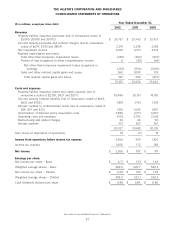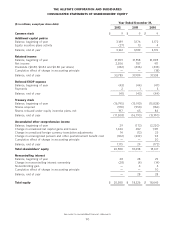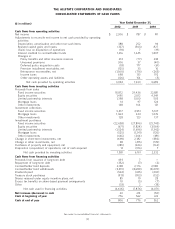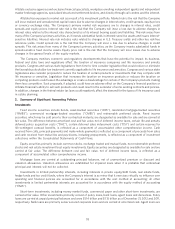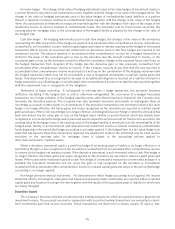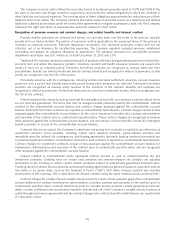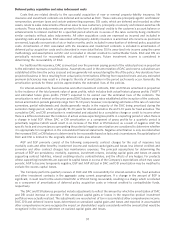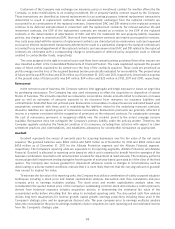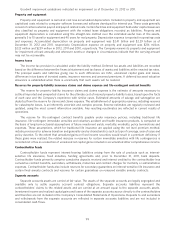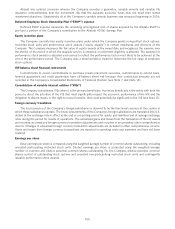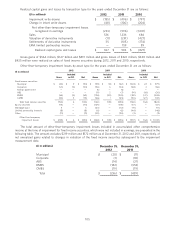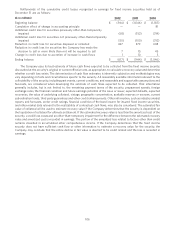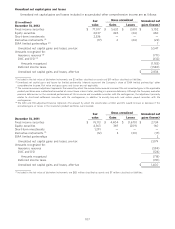Allstate 2013 Annual Report Download - page 213
Download and view the complete annual report
Please find page 213 of the 2013 Allstate annual report below. You can navigate through the pages in the report by either clicking on the pages listed below, or by using the keyword search tool below to find specific information within the annual report.Deferred policy acquisition and sales inducement costs
Costs that are related directly to the successful acquisition of new or renewal property-liability insurance, life
insurance and investment contracts are deferred and recorded as DAC. These costs are principally agents’ and brokers’
remuneration, premium taxes and certain underwriting expenses. DSI costs, which are deferred and recorded as other
assets, relate to sales inducements offered on sales to new customers, principally on annuity and interest-sensitive life
contracts. These sales inducements are primarily in the form of additional credits to the customer’s account balance or
enhancements to interest credited for a specified period which are in excess of the rates currently being credited to
similar contracts without sales inducements. All other acquisition costs are expensed as incurred and included in
operating costs and expenses. DAC associated with property-liability insurance is amortized into income as premiums
are earned, typically over periods of six or twelve months, and is included in amortization of deferred policy acquisition
costs. Amortization of DAC associated with life insurance and investment contracts is included in amortization of
deferred policy acquisition costs and is described in more detail below. DSI is amortized into income using the same
methodology and assumptions as DAC and is included in interest credited to contractholder funds. DAC and DSI are
periodically reviewed for recoverability and adjusted if necessary. Future investment income is considered in
determining the recoverability of DAC.
For traditional life insurance, DAC is amortized over the premium paying period of the related policies in proportion
to the estimated revenues on such business. Assumptions used in the amortization of DAC and reserve calculations are
established at the time the policy is issued and are generally not revised during the life of the policy. Any deviations from
projected business in force resulting from actual policy terminations differing from expected levels and any estimated
premium deficiencies may result in a change to the rate of amortization in the period such events occur. Generally, the
amortization periods for these policies approximates the estimated lives of the policies.
For interest-sensitive life, fixed annuities and other investment contracts, DAC and DSI are amortized in proportion
to the incidence of the total present value of gross profits, which includes both actual historical gross profits (‘‘AGP’’)
and estimated future gross profits (‘‘EGP’’) expected to be earned over the estimated lives of the contracts. The
amortization is net of interest on the prior period DAC balance using rates established at the inception of the contracts.
Actual amortization periods generally range from 15-30 years; however, incorporating estimates of the rate of customer
surrenders, partial withdrawals and deaths generally results in the majority of the DAC being amortized during the
surrender charge period, which is typically 10-20 years for interest-sensitive life and 5-10 years for fixed annuities. The
cumulative DAC and DSI amortization is reestimated and adjusted by a cumulative charge or credit to income when
there is a difference between the incidence of actual versus expected gross profits in a reporting period or when there is
a change in total EGP. When DAC or DSI amortization or a component of gross profits for a quarterly period is
potentially negative (which would result in an increase of the DAC or DSI balance) as a result of negative AGP, the
specific facts and circumstances surrounding the potential negative amortization are considered to determine whether
it is appropriate for recognition in the consolidated financial statements. Negative amortization is only recorded when
the increased DAC or DSI balance is determined to be recoverable based on facts and circumstances. Recapitalization of
DAC and DSI is limited to the originally deferred costs plus interest.
AGP and EGP primarily consist of the following components: contract charges for the cost of insurance less
mortality costs and other benefits; investment income and realized capital gains and losses less interest credited; and
surrender and other contract charges less maintenance expenses. The principal assumptions for determining the
amount of EGP are persistency, mortality, expenses, investment returns, including capital gains and losses on assets
supporting contract liabilities, interest crediting rates to contractholders, and the effects of any hedges. For products
whose supporting investments are exposed to capital losses in excess of the Company’s expectations which may cause
periodic AGP to become temporarily negative, EGP and AGP utilized in DAC and DSI amortization may be modified to
exclude the excess capital losses.
The Company performs quarterly reviews of DAC and DSI recoverability for interest-sensitive life, fixed annuities
and other investment contracts in the aggregate using current assumptions. If a change in the amount of EGP is
significant, it could result in the unamortized DAC or DSI not being recoverable, resulting in a charge which is included
as a component of amortization of deferred policy acquisition costs or interest credited to contractholder funds,
respectively.
The DAC and DSI balances presented include adjustments to reflect the amount by which the amortization of DAC
and DSI would increase or decrease if the unrealized capital gains or losses in the respective product investment
portfolios were actually realized. The adjustments are recorded net of tax in accumulated other comprehensive income.
DAC, DSI and deferred income taxes determined on unrealized capital gains and losses and reported in accumulated
other comprehensive income recognize the impact on shareholders’ equity consistently with the amounts that would be
recognized in the income statement on realized capital gains and losses.
97


